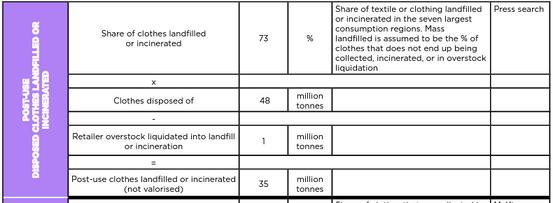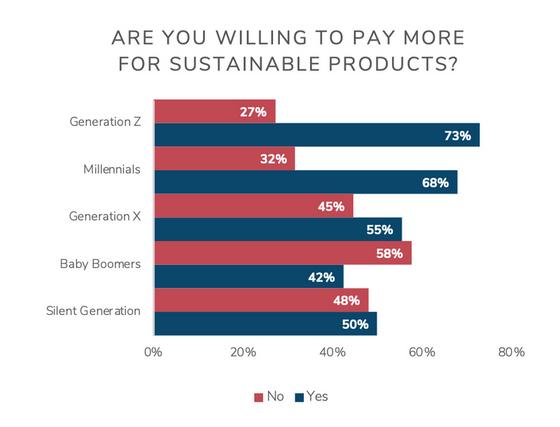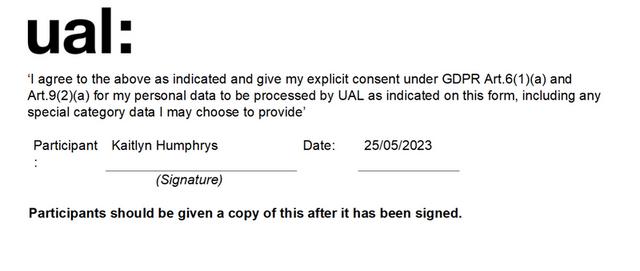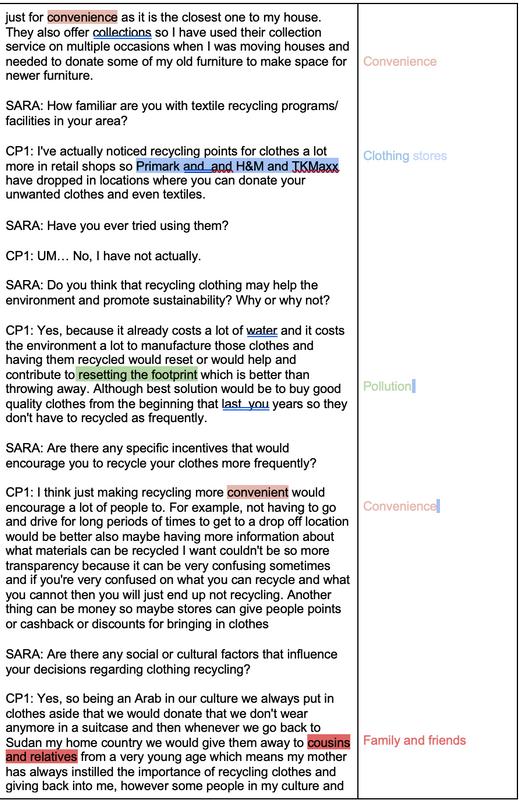Debunking Fashion Sustainability Myths and Facts: Intro to Consumer Behaviour and Market Research

BA Fashion Marketing and Consumer Behaviour
Unit Leader: Louise Stuart Trainor
FU010021
Word Count: 2,197
1 June 2023
I, Sara Al Nour, certify that this is an original piece of work. I have acknowledged all sources and citations. No section of this portfolio has been plagiarised.
Sara Al Nour 22003351
Executive Summary 1
This report debunks different myths and facts that are present in the fashion industry through fact checking them The report also focuses on one claim ,who the researcher ranked as a myth, that discusses Gen-Z and their 'lack' of recycling old unwanted clothes, however, after conducting primary research, the researcher finds out that the claim is in fact a myth
Four respondents were interviewed for 15 minutes and were asked questions regarding their attitudes to recycling and sustainability. The analysis of the primary research concludes that all respondents recycled their clothes to some degree, but the results may not be fully representative due to the small sample size and bias that may have occurred This can also be due to the sampling methods that the researcher has used.
In conclusion, this report analyses the sustainability of certain claims in the sustainable clothing sector and provides recommendations for fashion brands to better connect with their consumers when it comes to sustainability

Part 1: Exploring Myths and Facts
4
The fashion industry is filled with lots of statistics and claims on certain topics that aim to ‘educate’ consumers, however, many of these statistics and claims tend to be misleading information or false This section of the report explores 4 claims made about sustainable fashion and fact checks them in hope to try and find the primary source of the information to determine whether it is a myth or a fact In order to do so, a ranking scale has been put in place to help readers understand where the 4 claims can be reliable or not so reliable
How the ranking scale works
Each ranking is given a ranking from Red to Green, inspired by the claims-ranking system made by the New Standard Institute which is a non-porift advancing sciencebacked sustainability claims in fashion The scale goes from Red, which means that the claim has no primary source and should not be used, all the way up to Green, which in turn means that the claim has very reliable data and has passed the required fact checking process Green claims are encouraged to be used as they are the most dependable.
Green: Gold Standard
Greenish Yellow: Generally reliable
Yellow: Questionably reliable

Orange: Not reliable
Red: Not at all reliable
Myth-busting exercise
Greenish Yellow: Generally reliable

01 73% of the worlds clothing eventually ends up in landfills

This statistic has been used numerous of times when talking about the textile and fashion industry in regards to sustainability. Many articles have used this claim when urging consumers to recycle their more often or when talking about the consequences of fast fashion
Tracing the origins of this claim was fairly easy with the primary source of it being more often than not cited as the Ellen Macarthur Foundation, a non-profit organisation that is commited to creating a circular economy The 2017 report titled "A New Textiles Economy: Redesigning fashion’s future" where the report details how "the current clothing system is extremely wasteful" (Ellen Macaruther, 2017)




CHECKING PROCESS:
Figure 1: Article from WGSN on recycled fabrics (Olivia Barnes, 2018)
FACT 5
Figures 2-4: Ellen Macarthur Report (Ellen Macarthur, 2017)
02 6


28% of US Gen Z aged 18-25 are unable to save money
Yellow: Questionably reliable

This claim has not been around for a very long time, In fact, it only recently came alone due to the cost of living crisis and inflation of lots of everyday goods. This in turn has caused many consumers of the Gen-Z demographic to be unable to save money due to it being spent on their monthly necessities (Elizabeth Tan, 2022) As a result of this, many Gen-Z consumers are using recommerce as a more affordable option to buy and sell their clothes on platforms such as Vinted and Depop (Elizabeth Tan, 2023)



This claim is rated as being questionably reliable -this is because the primary has been found and was conducted by Qualtrics for Intuit Credit Klarma who published an article labelled "Cost of Living Crisis Spurs “Failure to Launch” among Gen Z", however, the actual report by Qualtrics cannot be found on Google or anywhere else making the claim not very reliable
FACT CHECKING PROCESS:
 Figure 5: WGSN Article (Elizabeth Tan, 2023)
Figure 6: WGSN Article (Elizabeth Tan, 2022)
Figure 7-9: Credit Karma survey, 2022
Figure 5: WGSN Article (Elizabeth Tan, 2023)
Figure 6: WGSN Article (Elizabeth Tan, 2022)
Figure 7-9: Credit Karma survey, 2022
US consumers across all generations are willing to spend more on sustainable products


The claim above has been tested as highly reliable due to the fact checking process being very easy to access Upon finding this claim on WGSN's article "Greenvertising: Shifts & Strategies " there was a score before reading the article that measured this arricle as "invest" which means that the contents of the article have been strongly invested and the trends discussed in the article have high consumer longevity.


FACT CHECKING PROCESS:

7
03
Green: Gold Standard
Figure 10: WGSN Article (Cassandra Napoli, 2023)
Figure 11-12: First Insight Report, 2020
04


Less than half (48%) of 18-24 year olds recycle their clothes


Orange: Not reliable


8
The claim above did not pass the fact checking process -this is because the primary source of the data is silenced data Silenced data is "data that exists but is privately controlled or exorbitantly expensive and thus not accessible to the public" (Transformers Foundation, 2021). Accenture published an article titled "Speed is This Season’s Hottest Fashion Trend, According to Research from Kurt Salmon, Part of Accenture Strategy" where the results of the report were explained, however, the link for the report was inaccessible
FACT CHECKING PROCESS:
Figure 13: WGSN Article (WGSN, 2017)
Figure 14-15: Accenture, 2017
Figure 16: Report not published/silenced data
Questions for fashion brands:
9
Fashion brand need to consider consumers attitudes towards sustainable fashion when creating strategies Below are some questions that some fashion brands may need to consider:
How does your brand's sustainable approach to fashion fit into consumers' personal values and lifestyles?
Are consumers more likely to be interested in your brand if you offer sustainable fashion choices at different price points?
Are consumers more likely to trust and support your brand if you partner with a well-known sustainability organisation or initiative?
What aspects of your brand's sustainable fashion offering resonate most with consumers?
How is social media used in shaping consumer opinion about your brand's commitment to sustainable fashion?
Are consumers more likely to engage with your brand if they are actively involved in your sustainability efforts and decision-making processes?
Part 2: Primary Research
A 15 minute interview was conducted on 4 participants where they were asked questions that circled amongst ethical sustainability and recycling The researcher aimed to find out if the statistic from Page 6 was true or false The statistic stated that "less than half (48%) of 18-24 year olds recycle their clothes" The researcher complied a list of questions (see below) and started their interview process The interviews were semi structured with the researcher asking all of the participants the questions below, however, some participants were asked different questions depending on their answers or were asked to further elaborate their answers.
Are you aware of what it means to recycle old clothing?
Do you recycle your clothing proactively? Why or why not
How frequently do you browse through your wardrobe to decide which clothing to keep and which to throw away?
What factors influence your decision to recycle or not recycle your clothes?
Have you ever sold or donated your old clothing rather than recycling it? If so, why did you make that decision?
How familiar are you with textile recycling programs/ facilities in your area?
Do you think that recycling clothing may help the environment and promote sustainability? Why or why not?
Are there any specific incentives that would encourage you to recycle your clothes more frequently?
Are there any social or cultural factors that influence your decisions regarding clothing recycling?
Lastly, do you think there is a need for more awareness and education about clothing recycling among young youths? Why or why not?
Each respondent was interviewed in different places which could have impacted their answers and how comfortable they felt when answering the questions CP1 was interviewed in their home, CP2 in a coffee shop, CP3 at the library and CP4 at UAL right after a lecture Moreover, all of these respondents did not have to meet a specific criteria other than the fact that they had to fit within the age group of 18-24 years old -because of this age cap, it had meant that most of the respondents were still students and had similar lifestyles These respondents were also chosen through convenience sampling (Saunders et al, 2019). Convenience sampling involves the researcher using participants that were easiest to obtain for their sample
10
Furthermore, the research was conducted ethically and the researcher was very adamant on this The contests were not put in any harm neither physical or psychological by participating They were also all asked to sign a consent form (see appendix) and their data was also anonymised. (Harrison et al, 2022). The researcher used the MRS code and adhered to it especially when it came to the participants rights where the researcher made sure "the participants were not misled" (MRS Code, 2023)
11
Part 3: Consumer Insights and Recommendations
Key Insights from primary research:
The researcher extracted a lot of data from the primary research that they had conducted -some quantitative but mostly qualitative due to the research instrument being an interview Some of the insights that the researcher found was that all of the participants recycled their old unwanted clothing to a certain degree Some recycled their clothes more than others, for example CP1 recycles their clothes every season whilst CP2 and 3 only do it every 6 months to a year Moreover, all of the participants seem to have a limited knowledge on recycling and what happens to their clothes after they give them away either to charities or to textile recycling programmes
All of the participants have never used any textile recycling programmes and were also not very familiar with them -some had knowledge of them but it was little to none (see appendix for interview transcripts). The participants that did know about textile recycling programmes tended to only know about ones that fashion brands owned such as H&M's textile recycling programme and not know any brands that actually specialised in that field such as Choice Textile for example
The theme of trends and trend cycling was also brought up by most of the participants which the researcher found very interesting CP2 and 3 both reported that they would more inclined to recycle more if it was seen as trendy or if more people around them had recycled as well, playing into the social influence aspect CP1 brought up the topic of trend cycling and how trends are coming in and going out of fashion very quickly and how that could cause some people to want to donate their clothes, whilst CP2 and 3 spoke about wanting to keep ahold of some items and not recycle them due to them being perceived as trendy and in the hopes of them coming back into fashion in the future
How frequently do you recycle:
12
6m-1y 50% 3m-4m 25% 2years 25%
Figure 17: Primary research results (Sara Al Nour, 2023)
Similarities and differences between primary and secondary research:
The original claim from Page 6 that the researcher decided to explore had silenced data Due to this, the researcher was not able to view the methodology of the original research which meant the researcher was unsure what exactly the study was measuring in terms of "recycling"
When conducting her primary research, the researcher decided to measure recycling as anything that fell under the category of -donating, clothes swapping, re-selling. In doing so, the researcher collected completely different results than the original research The researcher actually found out that all of the participants recycled their clothes, however, some recycled more frequently than others
The claim that less than 48% of 18-24 year olds recycle was ranked as not reliable at the start of this report After conducting her primary research, the researcher would still rank the claim as not reliable solely due to the fact the results from the research proved that 18-24 years olds do recycle their old unwanted clothing However, the results from the primary research could be untrustworthy, this is because the researcher only interviewed 4 participants who all lived in the same area and had very similar lifestyles Therefore, these results could be generalised to the wider population of 18-24 year olds Moreover, the participants could have lied about their responses or over-exaggerated the truth to seem more desirable This is known as social desirability bias and it could happen during interviews making the results less valid.
13
Recommendations for fashion brands:
There are many different ways in which fashion brands can have better reach and communication with their consumers regarding sustainability Those include:
Education All 4 participants agreed that in order for people to know more about sustainability, there needs to be more education on that topic Brands can do this in many different ways such as through product labels and semiotics in the clothes instruction labels just like CP1 had recommended. They can also invest more in content creation. By having a bigger budget, fashion brands cam be able to create campaigns that are informative and fun for consumers to watch They can also be more active on social media and create content on Instagram through reels or TikTok to reach a wider target On social media, they can also post polls and quizes and even go live with sustainability experts doing Q and A's where consumers can have their questions answered directly by experts in the area helping tap into the brands reach and credibility
Collaborations and
partnerships
Fashion brands can choose to collaborate with sustainable fashion designers such as Stella McCartney and Gabriella Hearst to showcase their commitment to sustainable fashion This will help draw in new consumers to the brands whose values are aligned with this alliance
Community Create a space for consumers interested in sustainability or want to know more about it through events and workshops. This would be a great opportunity for brands to talk exclusively with their costumers and heard their thoughts/critiques on the brand which they could use to improve on Moreover, through events, new ideas could get brought up that the brand may have not considered which they now can Brands can find that a sense of community centred around them through like-minded people could help increase brand loyalty.
14
Consumer Insight Board

15
Figure 18: Consumer insight board (Sara Al Nour, 2023)
Reference List
Harrison, M. Cupman, J., Truman, O., Hague, P.N. (2016) Market Research in Practice: an introduction to gaining greater market insight London: KoganPage Physical book
MRS CODE, (2023) MRS Code of Conduct
https://wwwmrsorguk/pdf/MRS-code-of-conduct-2023pdf
Macarthur, E (2017) A New Textiles Economy: Redesigning fashion’s future
https://ellenmacarthurfoundationorg/a-new-textiles-economy
Tan, E (2022) Cost of Living: US & UK Gen Z Spending
https://wwwwgsncom/insight/article/6328bbe85d5e75a903d8f7f6
Tan, E (2023) Gen Z: Fashion Recommerce Profiles 2023
https://www.wgsn.com/insight/article/63bed0214b03c45dbc18d058
Transformers Foundation (2021) COTTON: A CASE STUDY IN MISINFORMATION
https://wwwtransformersfoundationorg/cotton-report-2021
16
Image Reference
Figure 1
https://www.wgsn.com/fashion/article/79379
Figures 2-4
https://ellenmacarthurfoundationorg/a-new-textiles-economy
Figure 5
https://wwwwgsncom/insight/article/63bed0214b03c45dbc18d058#page1
Figure 6
https://wwwwgsncom/insight/article/6328bbe85d5e75a903d8f7f6#page1
Figures 7-9
https://www.creditkarma.com/about/commentary/cost-of-living-crisis-spursfailure-to-launch-among-gen-z
Figure 10
https://wwwwgsncom/insight/article/631501ba5dbb7e74f477695f
Figures 11-12
https://www.firstinsight.com/white-papers-posts/gen-z-shoppers-demandsustainability
Figure 13
https://wwwwgsncom/fashion/article/75632#page 2
Figure 14-15
https://newsroom.accenture.com/news/speed-is-this-seasons-hottest-fashiontrend-according-to-research-from-kurt-salmon-part-of-accenture-strategyhtm
CONSUMER INSIGHT BOARD
https://www.pexels.com/photo/women-posing-as-a-group-7325669/ https://wwwpexelscom/photo/women-shopping-in-a-clothing-store-5709656/ https://www.istockphoto.com/photo/asian-woman-who-manages-asecondhand-store-gm1172196322-325067066?
phrase=clothes+recycling&searchscope=image%2Cfilm
https://wwwpexelscom/photo/woman-in-white-dress-sitting-on-rock-by-thesea-13283050/
https://thesummerstudy.com/minimalist-makeup-brands-like-glossier/
17
Image Reference
https://wwwistockphotocom/photo/social-media-applicationsgm1371763060-441037484?phrase=social+media&searchscope=image%2Cfilm https://wwwistockphotocom/photo/a-group-of-young-adult-people-aremarching-together-on-strike-against-climate-change-gm1345174199423325823?phrase=sustainability+protest&searchscope=image%2Cfilm https://wwwstatistacom/statistics/1245513/us-social-app-average-hoursspent/
17

19 Appendix

20



21


22
Documentation of primary research

23

24

25

26

27

28

29

30

31

32

33

34














 Figure 5: WGSN Article (Elizabeth Tan, 2023)
Figure 6: WGSN Article (Elizabeth Tan, 2022)
Figure 7-9: Credit Karma survey, 2022
Figure 5: WGSN Article (Elizabeth Tan, 2023)
Figure 6: WGSN Article (Elizabeth Tan, 2022)
Figure 7-9: Credit Karma survey, 2022




























